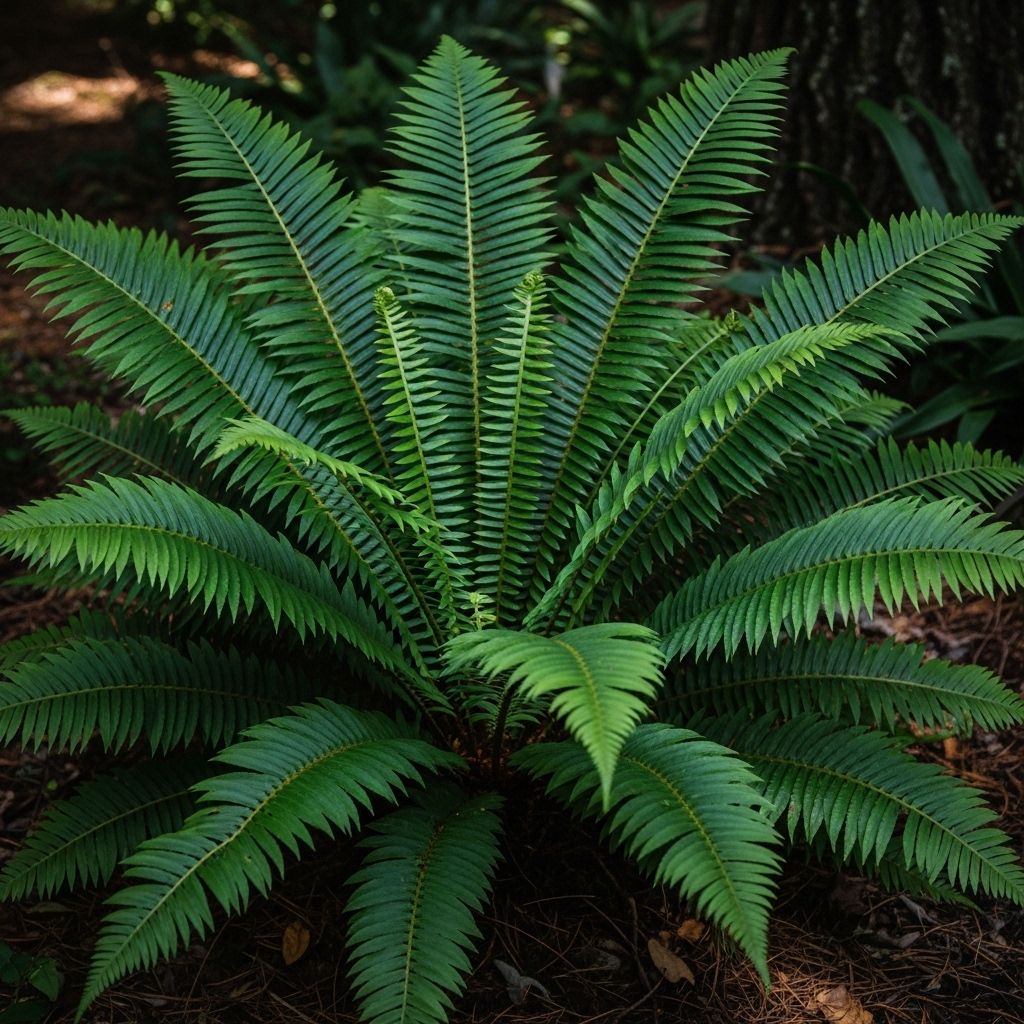Gardening 101: Western Sword Fern (Polystichum munitum)
Lush evergreen foliage supports wildlife and stabilizes soil in shaded garden corners.

Image: HearthJunction Design Team
Western sword fern is a defining feature of shady woodland gardens in the Pacific Northwest, celebrated for its vigorous evergreen fronds, low-maintenance needs, and ecological value as groundcover and erosion controller. In this comprehensive guide, discover how to grow, care for, and design with Polystichum munitum, the quintessential woodland fern.
Why Grow Western Sword Fern?
The Western sword fern offers:
- Lush, evergreen foliage: Architectural, sword-shaped fronds create instant woodland appeal year-round.
- Low maintenance: Adaptable and resilient once established; thrives in shade with minimal intervention.
- Wildlife-friendly: Non-toxic to pets and people, helps prevent erosion, and supports local ecosystems.
- Deer and rabbit resistant: Its leathery fronds generally deter browsing.
Meet the Plant: Western Sword Fern At a Glance
| Botanical Name | Polystichum munitum |
|---|---|
| Common Names | Western sword fern, sword fern |
| Family | Dryopteridaceae (Wood Fern Family) |
| Native Range | West Coast of North America (Alaska to California, east to the Rockies) |
| USDA Hardiness Zones | 3 to 8 |
| Height/Spread | 3 to 6 feet tall, 3 to 6 feet wide |
| Foliage | Evergreen, arching, sword-shaped, glossy green fronds |
| Soil | Moist, humus-rich, well-drained; slightly acidic |
| Light | Partial to full shade; filtered sun |
| Water | Moist soil preferred, drought tolerant after establishment |
| Maintenance | Low; remove old fronds in spring, mulch to conserve moisture |
| Toxicity | Non-toxic to cats, dogs, and humans |
Botanical Features
Sword ferns are instantly identifiable by their sword-like, leathery fronds that uncurl as bright green fiddleheads in early spring. As the season progresses, fronds mature to 4-6 feet long and form a vase-like, symmetrical clump. Brown clusters of spores appear on the lower surfaces of fertile fronds in late summer and autumn, a sign of a healthy, mature plant.
- Evergreen: Attractive foliage year-round, even during winter months.
- Form: Graceful, outward-arching shape creates texture and movement in the garden.
- Root system: Grows from dense underground rhizomes, allowing for gradual clump expansion and vegetative propagation.
Where Do Sword Ferns Grow Naturally?
Native to moist forests, shady slopes, and streambanks across the Pacific Northwest, Western sword ferns thrive under the dappled canopy of Douglas fir, redwood, and western hemlock forests. In gardens, their resilience and adaptability make them a core species for creating woodland settings.
Landscape Uses and Design Ideas
Sword ferns are versatile for a variety of garden settings:
- Groundcover: Quickly forms a dense, weed-suppressing carpet in shady borders, woodland gardens, or beneath trees.
- Erosion control: Robust root systems stabilize slopes and streambanks, reducing soil erosion.
- Naturalizing: Plant in drifts or clusters for a native, forest-like effect.
- Companion plants: Thrives alongside coral bells (Heuchera), columbine (Aquilegia), hosta, bleeding heart (Dicentra), and shade-loving perennials.
- Poolside or border accent: Lush foliage provides cool, green contrast to hardscapes and flowering plants.
How to Plant Western Sword Ferns
Site Selection
- Light: Partial to full shade; filtered sun is ideal. Avoid hot afternoon sun.
- Soil: Moist, humus-rich, slightly acidic, and well-drained. Mix in 30–40% bark dust or peat moss to increase organic matter and acidity if needed.
Planting Instructions
- Plant in early spring or late winter for best establishment.
- Dig a hole twice as wide as the root ball and no deeper than the crown. Do not bury the crown; the top of the roots should sit level with the surrounding soil.
- Loosen the fern’s roots gently before placing in the hole.
- Backfill with amended soil, pressing gently to remove air pockets.
- Water generously to settle the soil and hydrate roots.
- Apply a 2- to 3-inch layer of bark, compost, or leaf mulch to conserve moisture and protect roots.
Tip: Planting more densely (2-3 feet apart) creates a faster groundcover effect in wooded or shaded areas.
Sword Fern Care & Maintenance
- Watering: Maintain even moisture during first year. Once established, water weekly during dry spells; increase to two or three times per week during extreme summer heat.
- Mulching: Maintain a layer of organic mulch to regulate soil temperature and retain moisture.
- Pruning: Cut back old, faded fronds to the base each spring as new fiddleheads emerge. This encourages fresh growth and removes any winter damage.
- Fertilizing: Apply a balanced, slow-release fertilizer in early spring or top-dress with compost to support growth, especially in poor soils.
- Dividing: Large, crowded clumps can be divided every 4–6 years in early spring to rejuvenate and propagate plants.
Problems, Solutions, and Special Features
- Pest resistance: Rarely troubled by insects or disease.
- Deer/rabbit resistant: Foliage is unpalatable to browsing wildlife.
- Tolerance: Drought tolerant after establishment, but prefers moisture.
- Eco-friendly: Helps filter runoff and maintain healthy forest floors.
- Non-toxic: Safe for pets and children.
Propagation
- By division: The simplest method for gardeners. In early spring, dig up and divide clumps, ensuring each segment has a healthy rhizome and roots. Replant immediately and water well.
- By spores: More challenging but rewarding. Collect mature spores from the undersides of fronds in late summer/fall, sow on sterile, moist substrate, cover, and wait for germination. Spores can be difficult to propagate for home gardeners.
Western Sword Fern in Garden Design
Sword ferns are the backbone of naturalistic, woodland-themed landscapes:
- Plant in drifts alongside trillium, salal, oxalis, and other native woodland species for a lush, self-sustaining understory.
- Mass along shaded slopes to anchor soil and add structure.
- Pair with hostas and spring ephemerals for seasonal color changes.
- Mix with broadleaf evergreens such as rhododendrons for layered, year-round greenery.
Whether as a dramatic solitary specimen or as a workhorse groundcover, few plants rival the sword fern’s ability to transform dim garden corners into thriving green sanctuaries.
Frequently Asked Questions (FAQs)
Q: Will sword ferns grow in sun?
A: While sword ferns prefer partial to full shade, they can tolerate some morning or filtered sun, especially if the soil is kept consistently moist. Direct afternoon sun can scorch fronds or cause them to yellow.
Q: How do you revive a struggling sword fern?
A: Check for proper watering—overly dry or waterlogged soils can stress plants. Remove dead or brown fronds in early spring, and mulch heavily to conserve moisture. Relocate if site is too sunny or exposed.
Q: Are sword ferns invasive?
A: No, sword ferns expand gradually by rhizomes and are not considered invasive. Their growth is easy to control by dividing clumps every few years.
Q: Do sword ferns need fertilizer?
A: Fertilizer is optional if soil is rich in organic matter. A spring application of balanced fertilizer or compost can boost vigor where soils are poor.
Q: Is Western sword fern deer resistant?
A: Yes, sword ferns are generally not browsed by deer or rabbits, making them ideal for gardens with wildlife pressure.
Conclusion
The Western sword fern is a guiardian of shady gardens, combining evergreen beauty, ecological value, and nearly effortless care. If you crave a Pacific Northwest woodland look—lush, naturalistic, and abundant—few plants rival the impact and flexibility of Polystichum munitum. With minimal effort, you’ll enjoy thriving greenery and a touch of wild magic, season after season.
References
- https://scenichillfarmnursery.com/pages/western-sword-fern-growing-instructions
- https://www.gardeningknowhow.com/ornamental/foliage/sword-fern/sword-fern-care.htm
- https://www.epicgardening.com/sword-ferns/
- https://www.monrovia.com/western-sword-fern.html
- https://www.gardenista.com/posts/gardening-101-western-sword-fern/
Read full bio of Anjali Sayee












